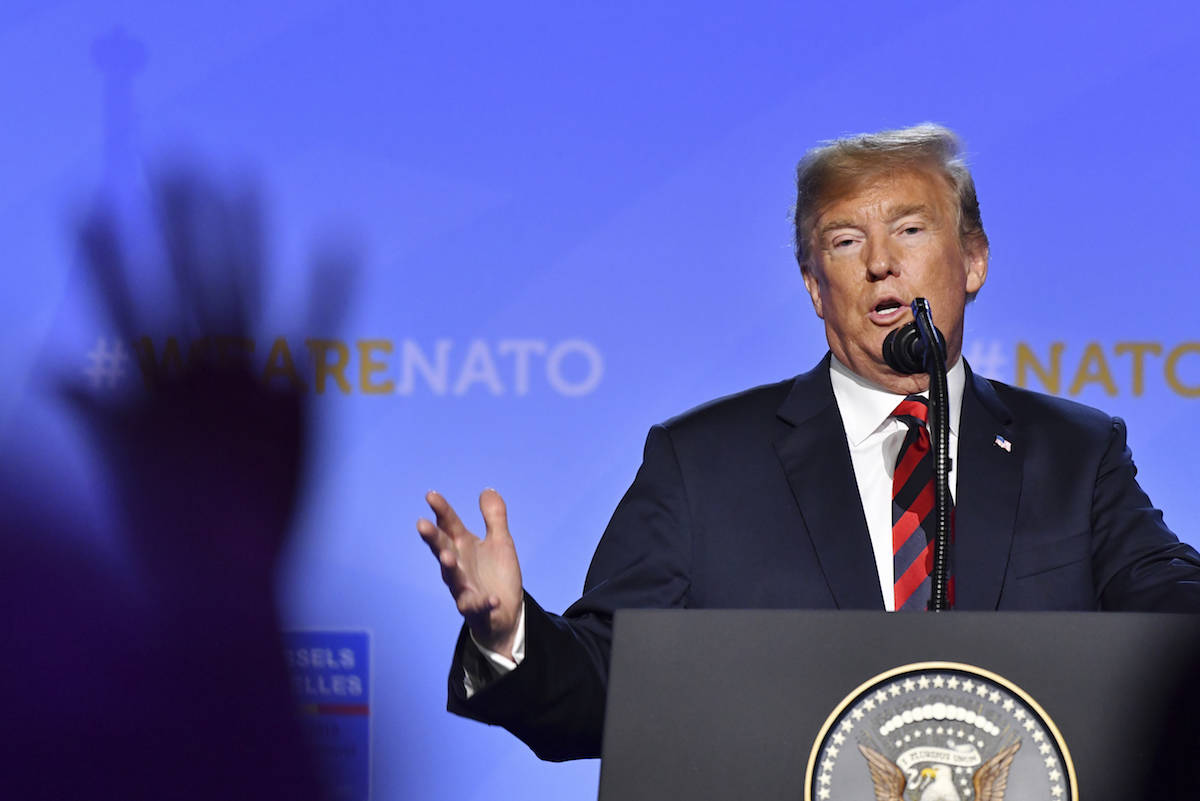It was only a matter of time.
Among the 2,000 or so reporters, photographers, producers, camera operators and other media professionals from across the world who attended this week’s NATO summit, there was little doubt Donald Trump would ignite some manner of fireworks. It was just a question of when and how.
For journalists covering the summit, the sequence of events of how Trump upended the final day of the event in Brussels was just as explosive and unpredictable as the news they had to report on.
Here’s a taste of the “Trump effect” on what is normally a carefully choreographed meeting of world leaders.
8:45 a.m., Brussels time.
The massive media hangar located within the new NATO headquarters compound was quiet. This was the second and final day of the summit, but most journalists accredited to cover the event had been operating on little sleep for several days, what with travelling and covering any and all developments relevant to their countries and audiences.
NATO leaders were only just arriving for the day, and nothing had really happened yet. The U.S. president had once again tweeted his displeasure about NATO allies for not ponying up their fair share of military spending toward transatlantic security. He had issued a similar tweet the previous evening, setting the stage for a showdown.
Related: Trump’s claim that NATO will boost defence spending disputed
Related: Trudeau bills 10-year defence spending plan as answer to Trump spending call
10:20 a.m.
Things were up and running, the regular buzz of the media centre had resumed, but things were strangely quiet on the NATO side. The presidents and prime ministers were meeting behind closed doors, ostensibly discussing the efforts of Georgia and Ukraine to join NATO as ally nations. But there had been no recent updates.
10:30 a.m.
A few tweets began popping up. Something was amiss behind the closed doors. One by one, news outlets began posting alerts citing sources confirming that NATO leaders were in the midst of an emergency session called after Trump demanded ally nations meet, or exceed, the two per cent spending targets agreed to in principle by the countries in 2014.
10:45 a.m.
Journalists were frantically typing out or live-reporting on air what few details they had confirmed and what the developments could mean for the treaty alliance’s future. There were questions about whether Trump had threatened to pull out of NATO entirely if his demands were not met. Reporters were on phones and laptops, working sources, trying to get any handle on what exactly was going on.
11 a.m.
One by one, small groups of journalists were heading out the door of the media centre and heading toward the area NATO leaders held their press conferences. But there was no official word yet that any press conference had been called.
The number of people heading for the door began grow, their strides picking up pace. Soon, a full-blown stream of journalists was pouring out, with cameras, notepads and phones in hand, some breaking out into a run.
Trump was giving a press conference.
11:10 a.m.
The firehose stream of journalists from the media centre was emptying into the largest of 13 press conference rooms set up in a large, white military-grade tent. Hundreds of television and still cameras were lined up in the dark room, with more arriving every minute. The camera operators jockeyed for positions with good angles. Journalists settled into chairs or crouched along aisleways, facing an empty stage set with a podium and two American flags.
Most journalists at the summit wouldn’t have laid eyes on the U.S. president in person, had it not been for this impromptu press conference on the final day. Summits are tightly controlled affairs, and this one in particular — which deals with defence policy — is especially tightly secured.
Reporters and photographers are ferried from one event to another in buses, given strict rules about where they can stand and how many questions they can ask — or not, as the case may be. Most of the press conferences or events are pooled to limit the number of journalists in any one area and avoid security or crowding concerns.
That’s why the open and free access to this event was unlike anything that had happened thus far.
12:25 p.m.
Finally, a voice through an unseen speaker made the announcement.
“Ladies and gentlemen, the president of the United States.”
And there he was, flanked by two of his right-hand men, Mike Pompeo and John Bolton.
The bright lights washed out the signature tone of his skin slightly, but it was indeed Donald Trump, in the flesh, talking about how he had single-handedly managed to elicit commitments from all NATO allies to increase their defence spending targets and calling himself “a stable genius.”
At first, White House press correspondents were the only reporters asking questions. Eventually, other savvy journalists in the room began to realize he seemed to be taking questions randomly from the crowd. Hands shot up, and some at the back of the room began pressing forward, hoping to get a question in.
But many happily remained in the back, watching the spectacle unfold. Here and there, journalists began turning around and snapping selfies, mid-press conference. Some even had their photographers shoot flash photos of them with Trump taking questions in the background.
The press conference took over the rest of the day’s narrative, with all other NATO leaders’ closing press conferences focused on responding to Trump’s bravado.
Did Trump cause the media frenzy that generally followed him throughout the summit, or did the media frenzy themselves by his very presence? Anything Trump is automatic headline material, it seems. Or, as he would say, ratings gold.
Newsworthy or not, it certainly is a spectacle to behold.
Teresa Wright, The Canadian Press



